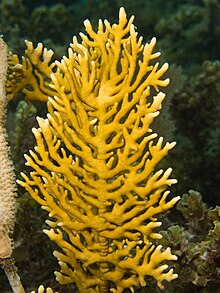Millepora alcicornis
| Millepora alcicornis | |
|---|---|
 |
|
| Scientific classification | |
| Kingdom: | Animalia |
| Phylum: | Cnidaria |
| Class: | Hydrozoa |
| Order: | Anthoathecata |
| Family: | Milleporidae |
| Genus: | Millepora |
| Species: | M. alcicornis |
| Binomial name | |
|
Millepora alcicornis Linnaeus, 1758 |
|
| Synonyms | |
|
List
|
|
Millepora alcicornis, or sea ginger, is a species of colonial fire coral with a calcareous skeleton. It is found on shallow water coral reefs in the tropical west Atlantic Ocean. It shows a variety of different morphologies depending on its location. It feeds on plankton and derives part of its energy requirements from microalgae found within its tissues. It is an important member of the reef building community and subject to the same threats as other corals. It can cause painful stings to unwary divers.
Millepora alcicornis is not a true coral in class Anthozoa but is in class Hydrozoa, and is more closely related to jellyfish than stony corals. Because of the variability in growth habit that this coral exhibits, it has been the subject of much confusion as to its taxonomy, being described under a number of different names from different localities. In 1898, Hickson decided that the variations in morphology were due to environmental factors and that Millepora alcicornis was the valid name for all these species. This conclusion has since been questioned.
The species was first described by Linnaeus in 1758, but his type locality is unknown. The scientific name comes from the Latin with Millepora meaning "thousand-pored" and alcicornis meaning "elk-horned". It seems likely that the type locality is in fact the West Indies. Explaining this in 1941 Crossland wrote "I cannot resist the remark that the one thing quite certain about the many forms of Millepora is that none of them have any resemblance to an elk's horn, except perhaps that from the West Indies".
The morphology of Millepora alcicornis is very variable. Most colonies probably start as encrusting forms and adopt a branching structure as they grow. The encrustations can become established on a variety of structures, not only on coral reefs and rocks but also on dead corals and the hulls of wrecked ships. Later development is in the form of plates or blades in habitats with much water movement such as the surf-pounded outer edges of reefs. In calmer waters, such as in deep lagoons or more sheltered parts of the reef, a more upright, leafy or branched structure develops which can grow to 50 centimetres (20 in) tall. The habit of growth is also influenced by the inclination of the surface on which the fire coral grows. On vertical surfaces, the encrusting bases are larger with longer perimeters and the density of branching is lower than it is on horizontal surfaces. The cylindrical branches usually grow in a single plane and span a range of hues from brown to pale, cream-like yellow, while branch tips are white.
...
Wikipedia

